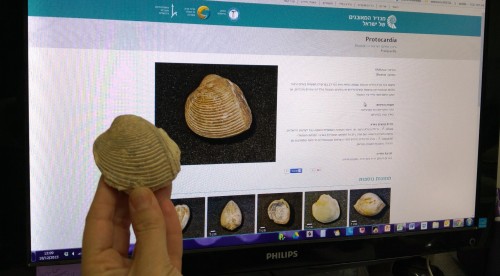The site was developed in scientific R&D in the Middle and Northern Arava

The world's first website for fossil identificationdefines the fossils of Israel", was launched as part of the agricultural exhibition that took place in the R&D (research and development) Middle and Northern Arava in Hatzava. The site is a continuation of a comprehensive study carried out by researchers and experts in the field of fossils in the desert.
The fossils found in this area are the product of a phenomenon that occurred hundreds of thousands of years ago in the Arava region, on the coastline of the ancient 'Tethys' ocean, an ocean that almost disappeared over the years, due to the shifting of the plates in the earth's crust and the convergence of the continents of Europe, Africa and the Arabian Peninsula. The only remnant of the Tethys Sea is the Mediterranean Sea. The largest fossil found in the steppe by the researchers is the last elasmosaur: fossilized skeletal remains of an ancient reptile 85 million years old. Researchers from the Dead Sea Science Center and Middle Arab R&D found tooth and jaw fragments, limb fragments, a fin, seven neck vertebrae and a dorsal vertebra of the Elasmosaurid reptile.
This is the first time that so many parts of a single individual have been excavated.
The website was founded by Dr. Sharit Ashkenazi-Polyboda from the Dead Sea and Arava Science Center and Middle and Northern Arava Science Research and Development at the "Yair" station in Hatzava, Dr. Hanan Ginat from the Science Center, Dr. Zeev Levy from the Geological Institute and Dr. Rivka Rabinowitz from the University the hebrew
The website lists the 170 most common fossils and information about them. The researchers built the website so that if there is no information about a particular fossil, you can send a request by clicking on the "hit the expert" button and forward a request that includes a photograph of the fossil to Dr. Zeev Levy from the Israel Geological Survey and Dr. Sharit Ashkenazi-Polyboda from the Dead Sea and Arabah Science Center and the Middle and Northern Arab R&D at the "Yair" station in Hatzava.
Dr. Sharit Ashkenazi-Polyboda said that the need to establish a site for identifying fossils stems from the fact that in Israel there is a large variety of rock units on which fossils appear, among which snails, oysters, ammonites and more are common, and that the fossils are an important tool for understanding the environmental conditions at the time the rock was deposited, for determining the age of the rock and for understanding The sequence of animal and plant development. In addition, the fossils are also a focus of attraction and interest for the general public, travelers, guides, pupils and students.
A fossil is actually a hard skeleton of bones or animal armor, which was buried in the sand and over the years with the hardening of the sand and the disintegration of the skeleton left its mark in the rock (usually sedimentary rocks). The age of the fossil is determined through a dating process for bedrock layers. A fossil is the proof of the existence of living creatures millions of years ago.
The purpose of the new website "The Fossil Definer of Israel" is to provide the general public and fossil enthusiasts with service and assistance, the website provides extensive information on the subject of fossils, among other things you can find many details about fossils that are over a centimeter in size, that stand out to the eye on the surface of the ground or in the rock. The site contains general information on the systems and classes of the fossilized animals and plants, as recognized by geologists today.
The site supports browsing from a smartphone or computer, in the Hebrew language and is very user-friendly. On the home page you can choose to filter by type, for those who are a little versed in the field of fossils, or alternatively filter by image. In this filter, images appear divided into three categories: general skeleton shape, decorations and other features. At the end of the filtering phase, an image corresponding to the selected parameters will appear as well as a short verbal description of the fossil. Today, fossils are research government property, and finding fossils must be reported and contacted, as there is a prohibition to take the findings and take them out of the environmental context.

One response
Beauty ! ! !